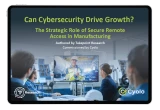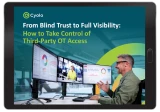Table of Contents
The manufacturing industry never stands still. Digitalization, automation, and IT/OT convergence are all making today’s factories smarter and more connected. And more dependent on outside expertise than ever before.
Original equipment manufacturers (OEMs), remote maintenance technicians, and specialist consultants are often the only people with the knowledge – or warranty permissions – to maintain certain critical systems. Without them, production lines grind to a halt.
But here’s the catch: allowing third-party vendors into your operational technology (OT) environment also opens the door to significant security risk. Especially if your secure remote access (SRA) solution wasn’t built with OT priorities in mind.
So, how can manufacturers strike the right balance between operational uptime and cybersecurity?
Let’s explore the risks of third-party access, why now is the best time to rethink your current strategy, and how leading manufacturers are improving their operational agility, reducing risk exposure, and staying compliant with the help of advanced, OT-specific SRA solutions.
Third-Party Access is the Backbone of Modern Manufacturing Operations
Any manufacturer will tell you that the average factory floor depends on a small army of third-party vendors. And they're not just background players. Quite the contrary, they’re vital for:
Maintaining high-value machinery like computer numerical control (CNC) machines, robotics, and specialized production equipment
Keeping systems under warranty by providing authorized OEM software updates
Meeting safety and compliance standards, including ISA/IEC 62443 and other industry-specific regulations
Providing rapid remote support, such as remote diagnostics during unplanned downtime, to keep lines running
For example, an automotive manufacturer might rely on robotic welders controlled by proprietary software. Only the OEM’s certified technicians are authorized to access these systems remotely. If their internal team attempts it, the warranty – worth hundreds of thousands of dollars or more – could be voided.
This means a single misstep could trigger not only serious financial penalties for the manufacturer, but also costly production delays while compliance is reassessed or equipment is recertified.
Instead of solving a problem, teams could find themselves stuck in a tangle of unplanned downtime and red tape.
This tale makes one thing crystal clear: you can’t run a factory without your vendors.
But without the right controls, giving them access can turn convenience into chaos.
The Hidden Complexity Behind Vendor Access
It’s one thing to let a vendor on-site. It’s another to give them remote access to sensitive OT systems – especially when:
They’re logging in remotely from hundreds of miles away or further
They use the same shared credentials every time across multiple environments
They’re connecting to legacy systems that don’t support modern security protocols
Now multiply that by 77.
According to 2024 research from the Ponemon Institute and Cyolo, that’s the average number of third-party vendors industrial organizations allow to access their OT environment. And a quarter grant access to over 100 vendors!
In addition, many of these third parties are linked to other partners, introducing cascading risk. A single breach can become a cyberattacker’s treasure, compromising several organizations in one fell swoop.
For instance, one cyberattack on a small maintenance provider could ripple into food production, automotive systems, or packaging operations across dozens of client sites.
In other words, it’s not just a single point of failure – it’s a domino effect of data disasters, toppling one system after the next.
Think of it like a tangle of conveyor belts on a busy production line. Each belt represents a vendor connection, shared credential, or legacy system. Everything’s moving fast, running in parallel. Just one small mistake – a compromised login or vulnerable legacy application – can knock the entire line into chaos.
That’s the level of risk manufacturers face when visibility and control over third-party access is missing.
The Answer? Treat Vendors Like Privileged Users
Third-party vendors are often treated as temporary outsiders.
But in reality, they have deep, privileged access to your most critical assets – including sensitive systems, machinery, production controls, and operational dashboards.
That kind of access demands more than trust – it demands control.
When manufacturers start recognizing that vendors are in fact privileged insiders, they’ll begin asking the right questions:
Do we know exactly what each vendor can access?
Can we limit their access to only what’s needed?
Can we supervise and record their sessions?
Can we instantly revoke access if something goes wrong?
This shift isn’t about unnecessarily restricting access for vendors – it’s about shaping that access to make it safer for everyone.
What Secure Third-Party Access Should Look Like
Manufacturers are increasingly recognizing that secure access tools designed for IT scenarios are unable to fully meet the needs of OT environments and cyber-physical systems. Those who have switched to SRA solutions purpose-built for OT are already enjoying:
Least privilege access with application-level permissions – so vendors only get access to the specific systems they need – not the whole network.
End-to-end visibility – so security teams can see and track every vendor connection from start to finish, providing full transparency across the entire session.
Agentless deployment – so vendors can get to work quickly without needing to install clunky VPNs or other software on their devices.
Real-time oversight and auditing – so admins can supervise and record sessions for compliance purposes and real-time intervention before things go awry.
Legacy system support – so even aging equipment can have protection through modern authentication, without costly overhauls.
Zero-trust approach – so every user must prove who they are, every time, with continuous identity-based verification. No assumptions, no risky IP-based access.
Access is Necessary, but Control is Critical
In the world of OT, privileged access doesn’t just mean elevated permissions – it’s a direct line to your most critical systems and carries serious risk if it isn’t controlled properly.
But there’s good news for manufacturers – they don’t have to choose between productivity and protection.
With an SRA solution that prioritizes securing privileged access scenarios, they can:
Connect vendors quickly and safely
Keep operations agile and efficienct
Minimize the risks of downtime, disruption, or data exposure
How? It starts with asking the right questions.
Discover the 8 essential questions every manufacturer should ask before saying “yes” to a new SRA tool in the Manufacturers’ Guide to Secure Remote Access for OT.
The Manufacturers’ Guide to Secure Remote Access for OT
8 Tips for Choosing a Future-Proof Solution

Jennifer Tullman-Botzer
Author
Jennifer Tullman-Botzer has over a decade of experience in cybersecurity marketing and is as tired as you are of hackers-in-hoodies stock images. She joined Cyolo in 2021 and currently serves as Head of Content. Prior to Cyolo, Jennifer worked in a variety of marketing roles at IBM Security. She lives in Tel Aviv, Israel.

Subscribe to Our Newsletter







